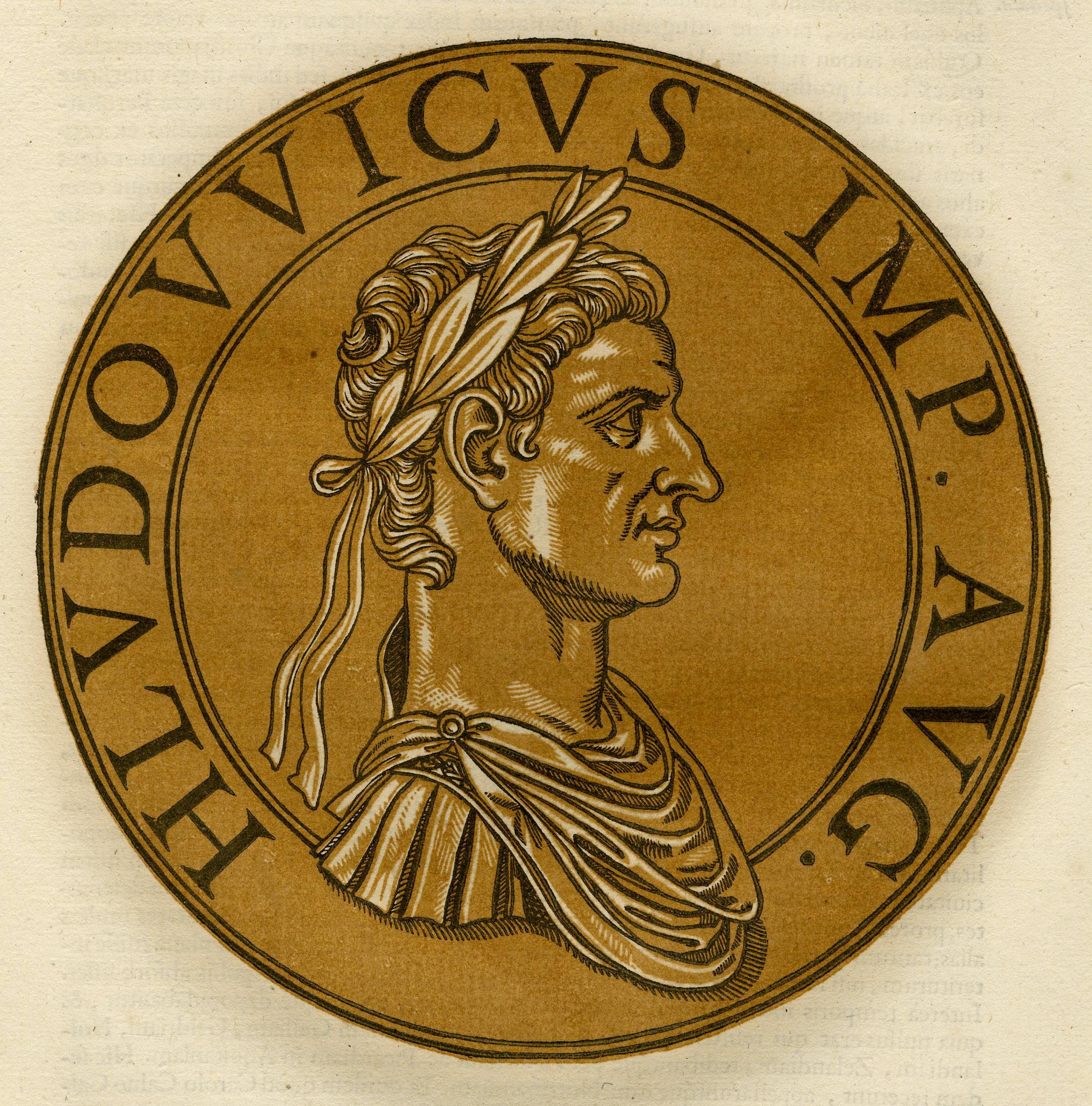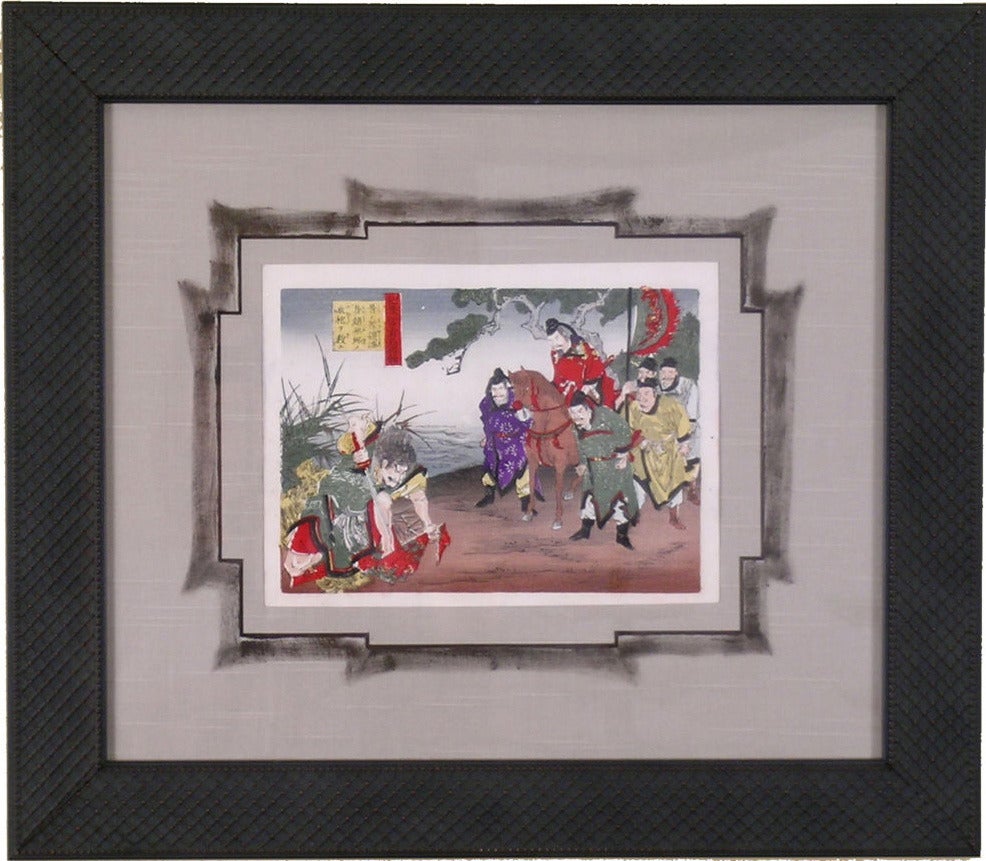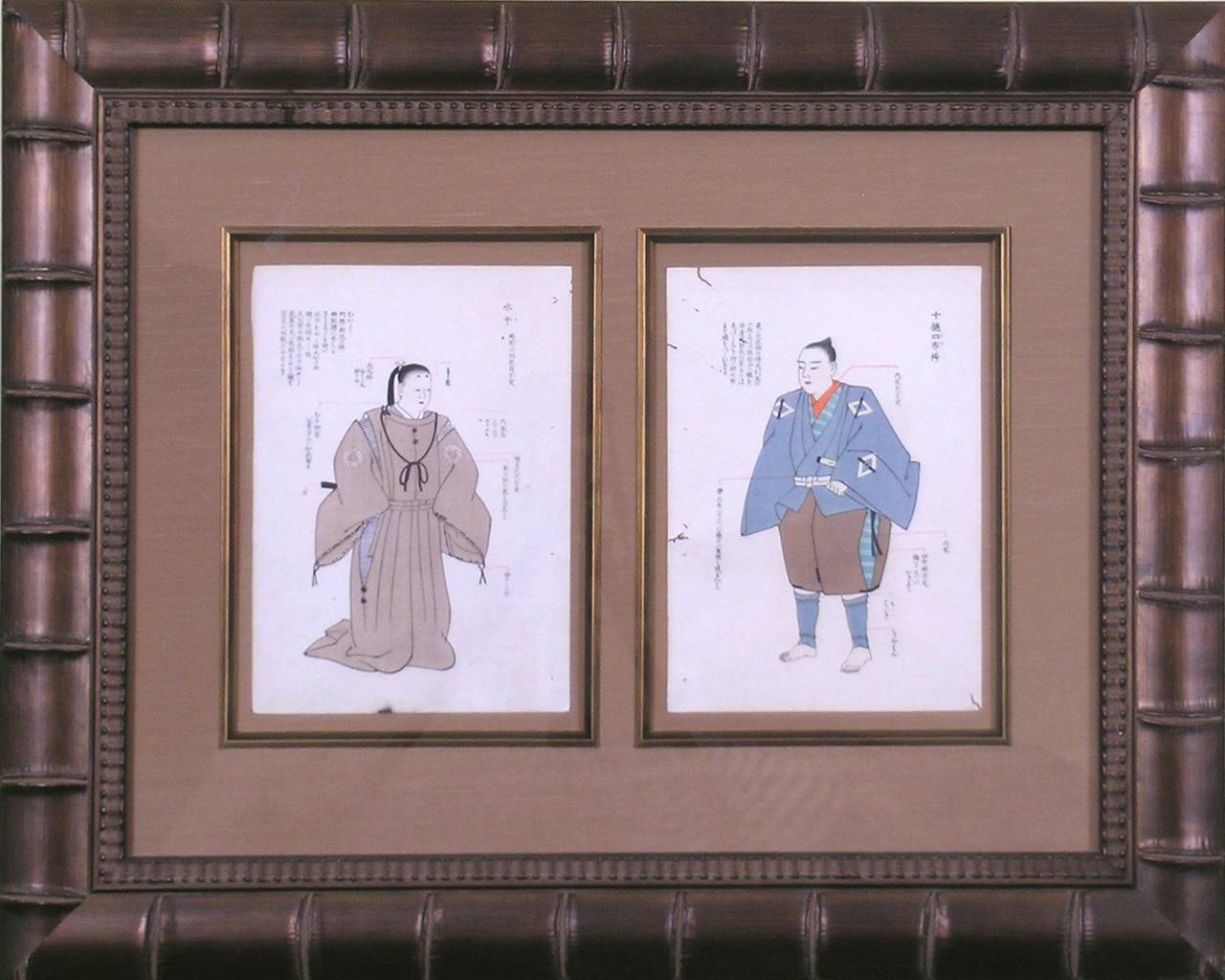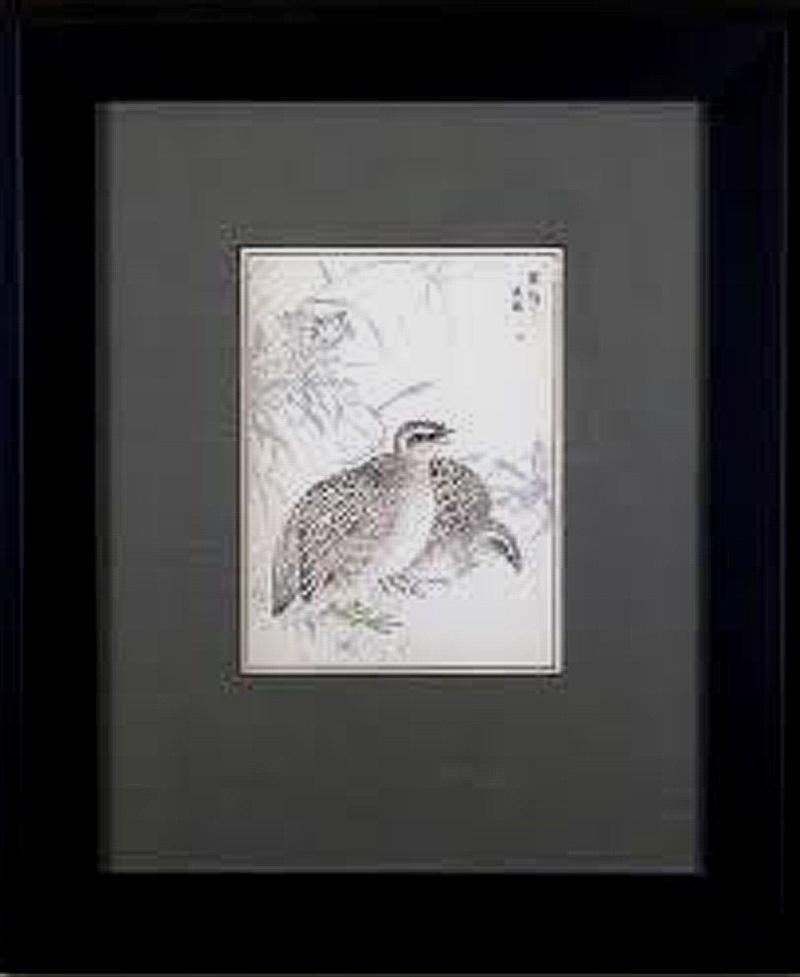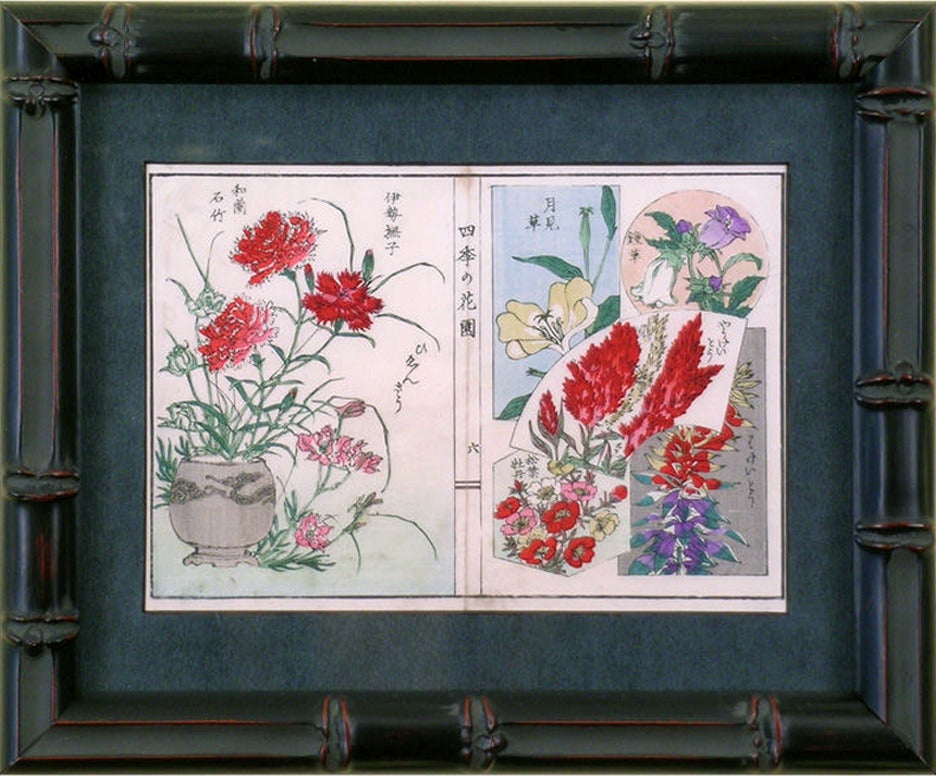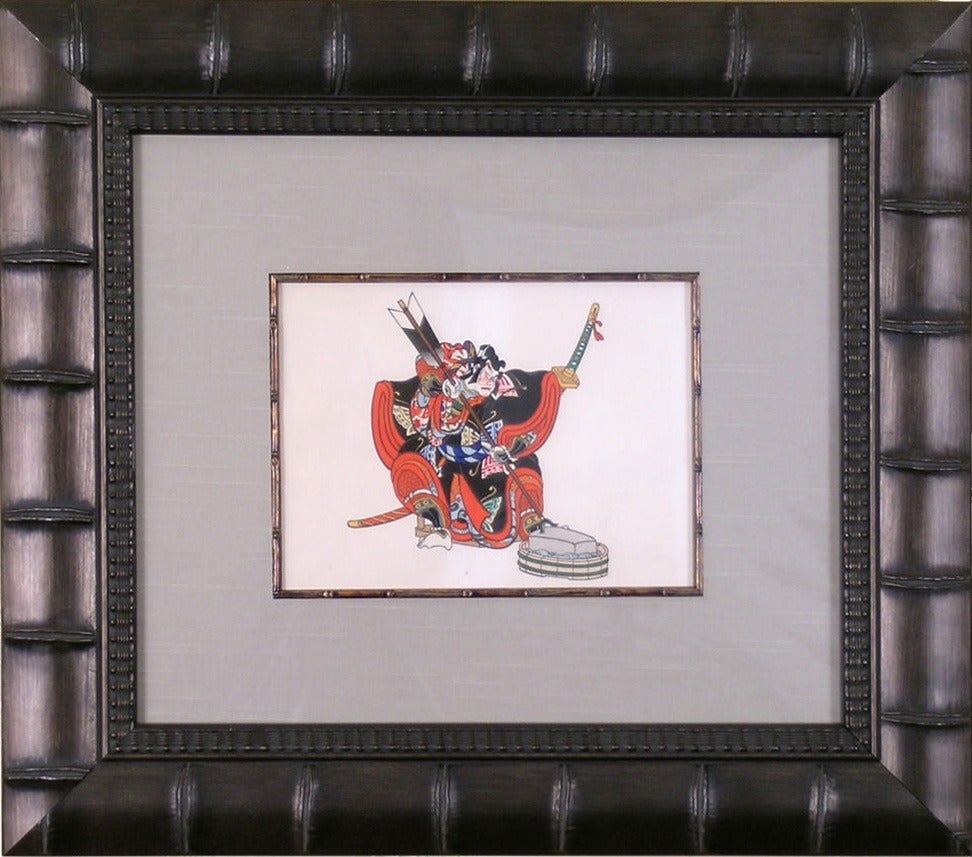Items Similar to Kabuki Theatre: Fuwa
Want more images or videos?
Request additional images or videos from the seller
1 of 6
UnknownKabuki Theatre: Fuwaca 1900
ca 1900
About the Item
Kabuki Theatre
Meji 33 (ca1900)
Woodblock
Original Hand-Color.
Woodblock printing flowered in the Edo Period, mid to late 19th century, and is still considered an art form of great precision and beauty. Following the artist sketch, an image is carved into a block of wood. Black inks form the outline of the flower and color inks are applied to specific areas. The woodblock is then pressed to hand-made screened paper which is then hung dry. The entire process of composing a single image can take weeks.
The history of kabuki began in 1603 when Izumo no Okuni began performing a new style of dance drama in the dry riverbeds of Kyoto, present-day Toyko. The style was immediately popular, and Okuni was asked to perform before the Imperial Court. In the wake of such success, rival troupes quickly formed, and kabuki was born as ensemble dance and drama performed by women—a form very different from its modern incarnation. Much of its appeal in this era was due to the ribald, suggestive themes featured by many troupes; this appeal was further augmented by the fact that the performers were often also available for prostitution.
Kabuki became a common form of entertainment in Yoshiwara, the registered red-light district in Edo. A diverse crowd gathered under one roof, something that happened nowhere else in the city. Kabuki theaters were a place to see and be seen as they featured the latest fashion trends and current events. The stage provided good entertainment with exciting new music, patterns, clothing, and famous actors. Often men would play both male and female roles. Performances went from morning until sunset. The teahouses surrounding or connected to the theater provided meals, refreshments, and good company. The area around the theatres was lush with shops selling kabuki souvenirs. Kabuki, in a sense, initiated pop culture in Japan.
Today, kabuki is the most popular of the traditional styles of Japanese drama—and its star actors often appear in television or film roles.
- Creation Year:ca 1900
- Dimensions:Height: 18.5 in (46.99 cm)Width: 21 in (53.34 cm)
- Medium:
- Movement & Style:
- Period:
- Condition:Clean, crisp image. Beautiful original colors. Framed to museum specifications using archival matting, backing, and hinging. Silk matting with wooden frame and fillet. Glazed with ultra-violet filtering Plexiglas.
- Gallery Location:Florham Park, NJ
- Reference Number:
About the Seller
5.0
Vetted Seller
These experienced sellers undergo a comprehensive evaluation by our team of in-house experts.
1stDibs seller since 2014
161 sales on 1stDibs
Typical response time: 2 hours
- ShippingRetrieving quote...Ships From: Florham Park, NJ
- Return PolicyA return for this item may be initiated within 1 day of delivery.
More From This SellerView All
- Samurai: Looking OnLocated in Florham Park, NJSamurai Warriors Meji 33 ( 1900) Woodblocks Original Hand-Color Woodblock printing flowered in the Edo Period in Japan, mid to late 19th century, and is still considered an art...Category
Early 1900s Academic Prints and Multiples
MaterialsWoodcut
- Kimono Design Men - Brown and BlueBy Matsui YuokuLocated in Florham Park, NJREISHIN GACHO (Album of Beautiful Designs) Japanese Kimono Designs Matsui Yuoku, Painter Japan, 1900 (Meiji 33) Honda Ichijirou, Publisher Woodblock Prints Celebrated as mu...Category
Early 1900s Academic Prints and Multiples
MaterialsWoodcut
- PartridgeBy Kono BaireiLocated in Florham Park, NJKono Bairei (1844 – 1895) Kacho-ga. (Birds and Flowers) Japan, c1880 Partridge Print. Okura Magobei, Publisher. The enthusiasm for nature prints transcends the centuries. “One Hundred Flowers” is a mid-nineteenth century work illustrating varieties of flowers in naturalistic styles. Traditional woodblock printing enhances the beauty of each work. The artist must carve different woodblocks for every color he wishes to transfer to paper. In this style of printing it is imperative that the register of each woodblock be exact as they must match perfectly to create an image without blurring. In addition to his illustrated flower books...Category
Late 19th Century Academic Prints and Multiples
MaterialsWatercolor, Woodcut
- Ikebana - Carnations and AstilbeLocated in Florham Park, NJIkebana Japanese Woodblocks. Meiji Period. Circa 1895. A disciplined art form, Ikebana seeks to bring nature and man together. The emphasis is on form and simplicity of design...Category
Late 19th Century Academic Prints and Multiples
MaterialsWoodcut
- Kabuki Theatre: Ya No Ne - The Arrow-HeadLocated in Florham Park, NJKabuki Theatre Meji 33 (ca1900) Woodblock Original Hand-Color. Woodblock printing flowered in the Edo Period, mid to late 19th century, and is still considered an art form of gre...Category
Early 1900s Academic Prints and Multiples
MaterialsWoodcut
- Samurai: Surprise AttackLocated in Florham Park, NJSamurai Warriors Meji 33 ( 1900) Woodblocks Original Hand-Color Woodblock printing flowered in the Edo Period in Japan, mid to late 19th century, and is still considered an art...Category
Early 1900s Academic Prints and Multiples
MaterialsWoodcut
You May Also Like
- Louis I of France as a Roman Emperor, in profile to the rightBy Christoffel JegherLocated in Fairlawn, OHLouis I of France as a Roman Emperor, in profile to the right Chiaroscuro woodcut, 1631-1633 Unsigned (as usual) After a drawing by Hubert Goltzius (1526-1583)...Category
17th Century Academic Portrait Prints
MaterialsABS, Woodcut
- Greek Architecture Blueprint of Ancient Amphitheatre Cyanotype Print, WatercolorBy Kind of CyanLocated in Barcelona, ESThis is an exclusive handprinted limited edition cyanotype. Details: + Title: Ancient Roman Amphitheater + Year: 2022 + Edition Size: 50 + Stamped and Certificate of Authenticity provided + Measurements : 70x100 cm (28x 40 in.), a standard frame size + All cyanotype prints...Category
2010s Academic Still-life Photography
MaterialsPhotographic Film, Woodcut, Emulsion, Watercolor, C Print, Color, Lithog...
- Tetbury Church - Signed Lithograph, Royal Art, Royal Heritage, Cotswolds, BritishLocated in Knowle Lane, CranleighTetbury Church by His Majesty King Charles III - Hand Signed Limited Edition Lithograph. Belgravia Gallery has been honoured to be associated with ...Category
1990s Academic Landscape Prints
MaterialsLithograph
- Overlooking Wadi, Saudi Arabia - Signed Lithograph, Royal Art, Mountains, AsirLocated in Knowle Lane, CranleighOverlooking Wadi, Asir Province, Kingdom Of Saudi Arabia by His Majesty King Charles III, (created when he was HRH The Prince of Wales) - ...Category
Early 2000s Academic Landscape Prints
MaterialsLithograph
- Windsor Castle - Signed Lithograph, Royal Art, Royal Homes, Windsor Castle, BritishLocated in Knowle Lane, CranleighWindsor Castle by HM King Charles III - Hand Signed Limited Edition Lithograph. Belgravia Gallery has been honoured to be associated with the artwo...Category
1990s Academic Landscape Prints
MaterialsLithograph
- Hong Kong from HMY Britannia - Signed Lithograph, Royal Art, Union Jack,Located in Knowle Lane, CranleighHong Kong From HMY Britannia by HM King Charles III - Hand Signed Limited Edition Lithograph. Belgravia Gallery has been honoured to be associated ...Category
Early 2000s Academic Landscape Prints
MaterialsLithograph
Recently Viewed
View AllMore Ways To Browse
Theatre Antique
Antique Theatre
Antique Print Block
Japanese Block Prints
Japaneses Block Print
Japanese Fashion Men
Midcentury Pop Prints
19th Century Theatre
Antique Original Japanese Woodblock Print
Japanese Woodblock Print Antique Original Prints
Japanese Print Actors
Woodcut Flowers
Wood Block Print Modern
Japanese Wood Block Prints
Wood Block Prints Japan
Pressed Flowers Art
Woodblock Print Of A Beauty
Kabuki Art
